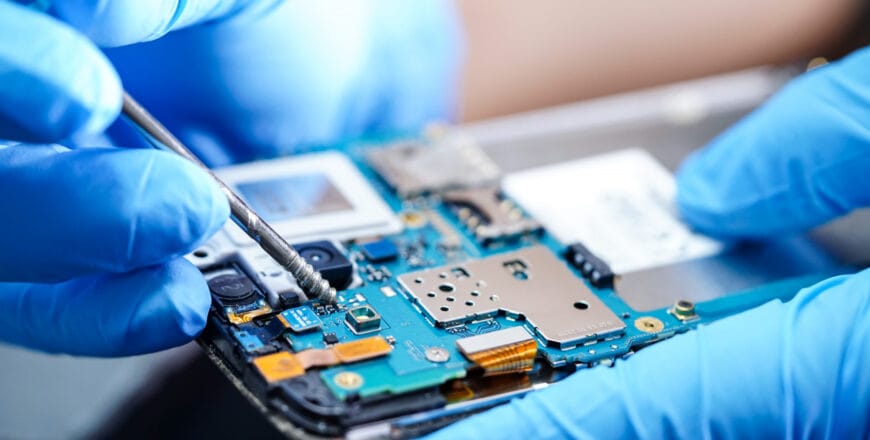Improving Repair Business Efficiency with Modern POS Solutions

Do you struggle to find the right piece of the puzzle to run your repair business?
We get it, cell phone repair is a challenging field that comes with a lot of hurdles. Whether you consider market competition or customer expectations, nothing sounds easy at first. That said, the key to success in this repair sector lies within the hands of the customer. So, how do you satisfy your customers as a cell phone repair business?
With modern cell phone repair shop software, you can automate everyday tasks and improve the accuracy and efficiency of your operations. This means you don’t have to turn away customers due to a slow billing process or due to the lack of spare parts required for the job.
The Transition to Digital Solutions from Manual Paperwork
Cell phone repair shops used to run on old-fashioned paperwork, manually managing inventory, invoicing, and client information. Forms had to be filled out, service tickets had to be written, and each repair procedure had to be meticulously documented. Parts were physically counted and stock lists were manually updated as part of inventory management. Even while these procedures worked well in earlier times, they are now antiquated and laborious in a world where people need services quickly and communicate instantly.
To address these inefficiencies, automated methods have taken over. Repair shops may handle customer information digitally, organize operations, and maintain inventory data in real-time thanks to these digital platforms. Now, systems may instantaneously alert employees when an item is low and update stock as parts are utilized. Both customers and employees save time and energy as a result of this digital evolution, which streamlines the entire process.
Moreover, here are some of the products you must have at your repair store if you want it to thrive.
Improvements in Repair Process Efficiency
Repair shops can operate more efficiently thanks to automated systems. Staff members may rapidly enter a customer’s information into the system when they walk in for a repair, and the system will create a digital work order. Workers can view the work order at every repair station, which guarantees uniformity and lowers the possibility of data loss. By doing this, the lengthy documentation that previously postponed repairs is removed, and the customer experience is enhanced.
Repair businesses are able to track each repair’s progress in real time by using digital tracking. When a customer’s phone is prepared for pickup, they receive an automated notification, which cuts down on wait times and improves convenience. Once requiring multiple papers and signatures, repairs now only require a few clicks, allowing personnel to concentrate on repairs rather than paperwork.
Automated Inventory Control
Inventory control has always been one of the most tiresome parts of operating a repair shop. Manually updating parts lists and doing stock counts takes time and is prone to mistakes. A store may experience delays and disgruntled customers if a frequently used part goes out. This issue is resolved by automated inventory management, which tracks stock levels in real time.
These systems automatically record each part that is taken out of stock or added to the inventory. The technology may alert employees or even place a new order with suppliers when an item exceeds a predetermined minimum level. By maintaining ideal inventory levels, this procedure guarantees repairs are finished on schedule, reduces delay brought on by missing components, and avoids overstocking. High-volume repair shops that do numerous repairs every day can particularly benefit from automated inventory management.
Simplified Billing and Invoicing for Quicker Payment
In repair shops, automation has also taken the place of manual paperwork in billing and invoicing. Repair workers used to have to manually compute labor and part costs and write out invoices by hand, which might have resulted in errors and late payments. This procedure is made simpler by automated invoicing, which computes pricing automatically, generates expert invoices in a matter of seconds, and saves client information for convenient access in the future.
Repair shops may transmit bills to clients immediately using automated invoicing, enabling quicker and more dependable payments.
Security of Data and Decreased Human Error
Manually managing client information and repair records increases the risk of errors and data loss. Paper documents are easily lost, damaged, or misplaced, which can cause major problems, particularly in the data-sensitive world of today. By safely keeping all client data in a digital format, automated methods remove this risk. Customer privacy and data integrity are protected by the encryption, backup, and easy retrieval of information.
Furthermore, human error—which can frequently occur in manual documentation—is decreased by automated systems. Automation guarantees precision at every step of the repair process, from figuring out part costs to documenting serial numbers and service histories.
Better Customer Experience with Communication and Transparency
The capacity of automated systems to notify clients at every stage of the repair procedure is one of their biggest benefits.
The Bottom-line
The industry is changing as a result of cell phone repair shops replacing manual paperwork with contemporary automated technology. These systems improve efficiency on all fronts, from automated inventory and streamlined procedures to safe data management and quicker billing. Repair shops can enhance their operations and provide a better client experience by implementing automated solutions. This change represents a major advancement for the sector and demonstrates that automation is now essential for expansion and success in the cutthroat market of today.




